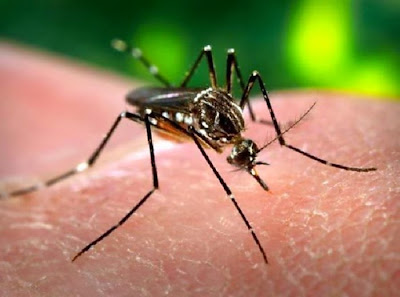What is yellow fever?
Yellow fever is an infectious disease caused by the yellow fever virus, which is spread by mosquitoes. The disease occurs only in Africa south of the Sahara (approximately 180,000 cases per year) and South or Central America (about 20,000 cases per year). Yellow fever virus belongs to the flaviviruses, but was once wrongly under the togaviruses rallied. The yellow fever virus is a single-stranded RNA virus that is 35-45 nm in size. Not all mosquitoes can transmit yellow fever viruses. In Africa, it usually involves the Aedes aegypti or Aedes africanus, in South America are often mosquitoes of the genus Haemagogus. Via the salivary glands of the infected mosquito comes on to the virus in the body and infects lymphocytes. Through regional lymph node stations then the virus spreads into the rest of the body. Mosquitoes that stabbing an infected monkey or human, after 2-3 weeks contagious.
Each year, may be in an area with a lot of transmission or a few per cent of the available population are infected with yellow fever virus. In young adults may be found in such an area of the reasons why the majority of antibodies against yellow fever. In the Netherlands, there is no yellow fever identified in more than a decade.
Epidemiology
Are two types of transmission are:
- The sylvatic form (jungle form).
- The urban form.
The urban form is transfer into the city from mosquitoes to humans. There are no monkeys here serve as a reservoir. This is the type of transfer that most human cases of disease caused in the form of epidemics.
There has never been transmission of yellow fever among humans demonstrated. The reason that in the Middle East, and Asia no yellow fever occurs despite the fact that the equipment needed to mosquitoes (A. aegypti) occur on a large scale, is not known. The symptoms are identical in these two forms because it is the same virus.
Yellow fever symptoms
The disease usually subclinical, less than a quarter of patients develop symptoms of yellow fever. The mortality rates can be as much as twenty percent or more of all patients, partly dependent on the virulence of the virus. The incubation period is quite short with 3-6 days. Hereafter arise symptoms that may range from complaints range from a 'flu' to a severe hemorrhagic fever. The complaints begin acutely and are usually high fever, myalgia, malaise, headache, nausea, vomiting and possible jaundice. The pulse is often slower than expected. After this, a recovery after which a small proportion of patients a few hours to a day later still gets severe symptoms. The symptoms are (bloody) diarrhea and other bleeding, abdominal pain, severe jaundice, neurological disorders and shock. Up to half of this group dies from the disease.
Yellow fever treatment
There is no causal treatment of yellow fever so that the treatment is necessarily symptomatic. Whether this contributes to a better prognosis is questionable.
Prevention - yellow fever vaccine
In the 1930s, two vaccines developed against yellow fever. The first is the FNV-vaccine (grown on mice brain) and the second the 17 d vaccine (grown on chicken eggs) that now still the only is used. It is a vaccine with attenuated live gelekoortsvirussen. The FNV-vaccine had the disadvantage that there occurred relatively often encephalitis in children making it after 1961 was no longer recommended for children under the age of ten years. For 1961 the in French Africa is widely used and it turned out to be very effective. The 17 d vaccine protects certainly ten years but probably lifelong. It is not given to children under 6 months and to the elderly. In these groups is the risk of brain inflammation by the vaccination relatively large. Since 1980 many countries of mass vaccination passed on vaccination in outbreaks of yellow fever. Also addressed is the mosquito control less stringent than it used to be. This causes yellow fever for more than it used to be. Many countries where yellow fever endemic couples vaccination mandatory for visitors.
As a precaution in the line waiting 4 weeks after administration of live vaccines before immunosuppressive medication (again) starts up.


